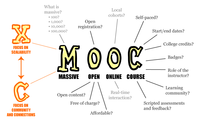
Photo from wikipedia
Massive open online courses (MOOCs) are designed as stand‐alone courses which can be accessed by any learner around the globe with only an internet‐enabled electronic device required. Although much research… Click to show full abstract
Massive open online courses (MOOCs) are designed as stand‐alone courses which can be accessed by any learner around the globe with only an internet‐enabled electronic device required. Although much research has focused on the enrolment and demographics of MOOCs, their impact on undergraduate campus‐based students is still unclear. This article explores the impact of integrating an anatomy MOOC in to the anatomy curriculum of a year 1 medical degree program at the University of Leeds, United Kingdom. The course did not replace any teaching that was already being delivered, and was used to supplement this teaching to support the students' consolidation and revision. Analysis of student feedback indicates a high level of usage, with evidence to suggest that female learners may have approached the course in a more personalized manner. Although the video based resources and quizzes were greatly appreciated as learning tools, significant evidence suggests the students did not engage, or were inclined to engage, with the discussion fora. Furthermore, a significant majority of students did not want the MOOC to replace the existing teaching they received. Given the feedback provided, this research suggests that although the student population believe there to be value in having access to MOOC material, their role as replacements to campus‐based teaching is not supported. Details regarding the enrolment and engagement of the general public with the MOOC during the two runs are also documented, with the suggestion that graduates employed in the healthcare sector were the primary users of the course. Anat Sci Educ 10: 53–67. © 2016 American Association of Anatomists.
Journal Title: Anatomical Sciences Education
Year Published: 2017
Link to full text (if available)
Share on Social Media: Sign Up to like & get
recommendations!